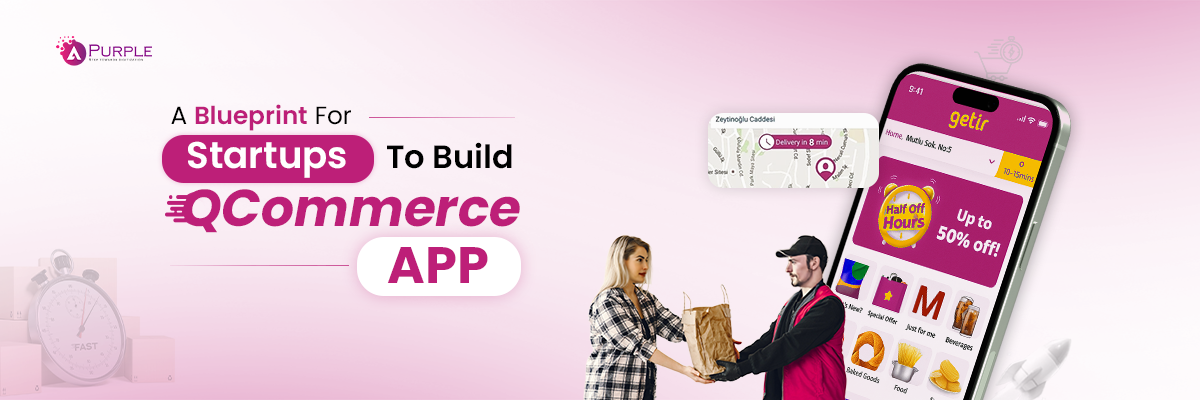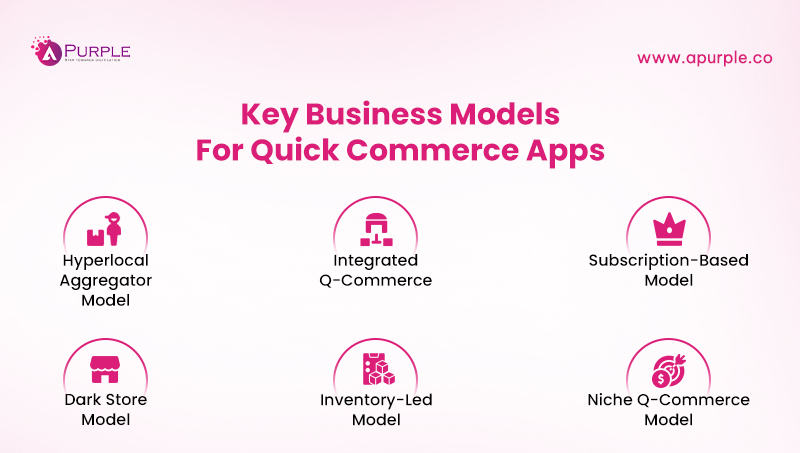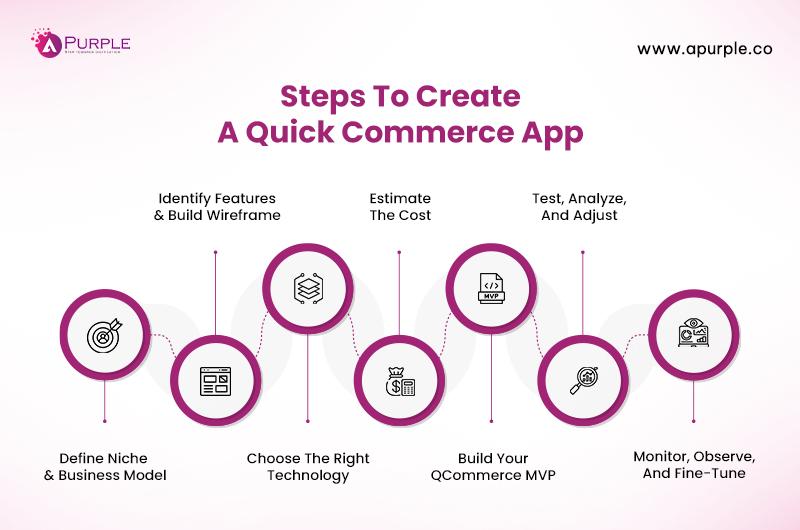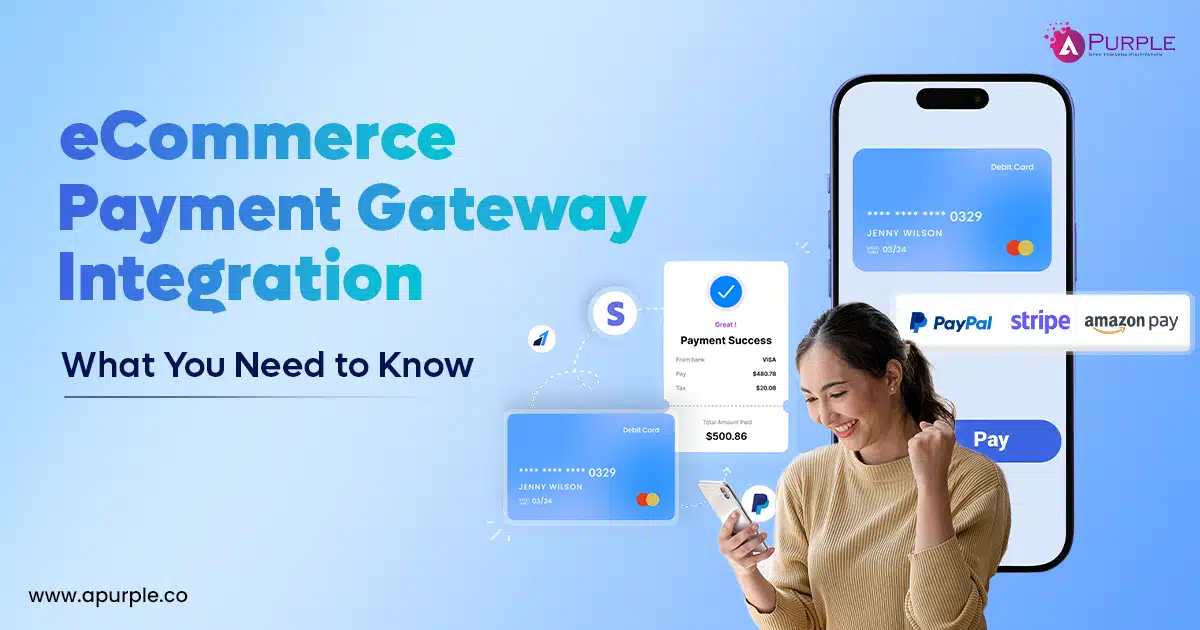
Customers don’t want fast, they want instant.
That’s why quick commerce has become the most attractive market for startups, convenience store chains, and eCommerce brands.
But building a quick commerce business has its challenges, and to overcome them, you need to understand,
- What is Quick Commerce?
- How is it different from traditional eCommerce?
- What does it cost to build a Q-Commerce app?
- And how do you avoid the pitfalls that drain time, money, and reputation?
This guide provides not only answers to the above questions but also a blueprint that helps you build a successful quick commerce business. Let’s get started.
What Is Quick Commerce?
Quick commerce, or QCommerce, is a subset of eCommerce services that focuses on delivering products ultra-fast (10 to 30 minutes) to customers. It offers higher customer satisfaction levels, improved inventory management, and higher sales.
As a startup, how quickly you can deliver a product will matter the most if you are planning to build a QCommerce startup.
But what makes this ultra-fast delivery possible?
Short answer- “dark stores”
What Are Dark Stores? [The Backbone Of QCommerce]
Dark stores are retail outlets, warehouses, or distribution centers strategically located near customers’ locations. Despite the term “store,” dark stores do not allow customers to enter and shop in them directly. Instead, QCommerce startups leverage dark stores to deliver products directly to customers quickly.
Everything from the dark store design to processes and workflow is designed for speed. These stores are technology-driven and need a reliable software system to ensure streamlined operations. But creating a dark store is not the starting point of your QCommerce startup.
How To Start A Quick Commerce Business?
Starting a QCommerce startup requires a well-planned strategy, including identifying the target audience, creating a business plan, developing a tech platform, testing it, and deploying it. Here are the key steps you can follow to start your quick commerce business.
1. Plan Your QCommerce Startup
Planning your quick commerce startup requires identifying the target niche. For example, GoPuff offers deliveries of alcohol, groceries, food, and other products within 15-30 minutes. Similarly, you can differentiate your niche audience through the specific items you deliver, such as fashion, groceries, pet products, and food.
2. Conduct Market Research
Research your audience based on various parameters, such as delivery speed expectations, product preferences, price sensitivity, brand perception, and loyalty. Plus, you can analyze competitors, industry reports, and quick commerce trends to build a startup plan.
3. Select Your Business Model
Now that you have identified the niche and defined the audience, you need a plan to build a quick commerce business. This plan will encompass everything, from selecting a quick commerce business model and target market to analyzing competitor strategies and estimating the total cost.
Here are some of the crucial aspects of your plan that you need to strategize,
- Funding sources
- Legal registrations and licensing
- Quick commerce app development
- Building a logistics network
- 3PL (Third-Party Logistics) partnerships
- Inventory management
4. Building Your QCommerce Platform
Knowing what quick commerce is and planning to build one for your startup requires a strategic approach. From building software for dark stores to developing a quick commerce app and creating the product catalog, you need a strategy.
Here are some key activities to build your QCommerce platform,
- Build and launch quick commerce apps for customers and delivery people.
- Develop systems to manage orders, process payments, and facilitate customer communications.
- Ensure accurate product information through categorizations.
- Implement efficient systems for order processing, picking, packing, and delivering products to ensure seamless operations.
- Leverage AI-based systems to optimize delivery routes and delivery time.
5. Optimized Customer Experience and Marketing Efforts
Launching your quick commerce startup app doesn’t end with deployment. You need to monitor customer experience and its bottlenecks. You also need strategic marketing efforts to improve visibility among the target audience.
The above process has many layers that you need to understand in-depth, like quick commerce business models and the app development process But before discussing them, let’s first understand the key benefits of the QCommerce platform.
What Are The Benefits And Disadvantages Of Quick Commerce?
Quick commerce offers unique benefits for startups and users, like higher revenue potential and faster deliveries.
Benefits Of Quick Commerce For Startups
| Benefit | Description |
|---|---|
| Higher Sales And Revenue | Quicker product delivery encourages customers to make impulse purchases, resulting in higher sales and increased average order values. |
| Competitive Advantage | Startups can leverage quick commerce platforms to generate repeat business and create unique value propositions. This offers a competitive edge. |
| Better CX | Offering products within a shorter timeframe helps startups improve customer experience and meet customer expectations. |
| Higher Operational Efficiency | Leveraging AI and machine learning, startups can optimize inventory management, predict demand, and allocate resources more effectively. |
| Efficient Logistics | QCommerce startups need dark stores to operate, which helps reduce logistics complexities. |
| Reduced Waste Management | This approach of delivering products faster has lower upfront costs compared to the conventional retail method. |
| Faster Scaling | QCommerce enables startups to scale, leading to increased revenue and a broader customer base. |
Benefits Of Quick Commerce For Users
| Benefit | Description |
|---|---|
| Faster Delivery Times | Orders are delivered ultra-fast, often within 10–30 minutes, saving users time and meeting urgent needs. |
| Instant Gratification | Users get immediate satisfaction by receiving products quickly, fulfilling their desire for instant access. |
| Better Convenience | Easy ordering through user-friendly apps and websites enables quick and seamless shopping from the comfort of your own home. |
| Access to a Wide Range of Products | Quick commerce platforms partner with various retailers, providing users with fast access to a diverse range of products. |
| Increased Customer Satisfaction | Fast and reliable delivery leads to higher satisfaction and loyalty among users. |
| More Frequent Purchases | Quick delivery encourages users to order more often, including impulse and last-minute buys. |
| Competitive Pricing & Offers | Platforms often offer attractive deals and discounts to retain customers, thereby enhancing user value. |
Now that you know what is q-commerce and its benefits, understanding the difference between conventional eCommerce and this approach is also essential.
What Is The Difference Between ECommerce And Quick Commerce?
Quick commerce differs from the conventional eCommerce approach in several ways. Some of the significant differences include delivery speed, inventory scale, customer preferences, and operational costs.
| Differences | Quick Commerce | Traditional ECommerce |
|---|---|---|
| Delivery Speed | Faster deliveries, often arriving within an hour. | Standard deliveries are made on the same day or within a few days, depending on the location and product. |
| Product Range | Limited to essential items, groceries, and small goods. | Extensive coverage of products across categories. |
| Inventory Model | Uses dark stores for order fulfillment. | Has a large centralized warehouse for order processing. |
| Customer Behavior | Cater to impulse purchases and immediate customer needs. | Addresses a much more researched purchase. |
| Operational Costs | High operational cost due to the need for last-mile delivery and local infrastructure, like a dark store. | Lower operational costs are achieved through bulk orders and centralized warehousing. |
Now that you know the difference between quick commerce and eCommerce services, it’s time to decide which business model to use for your venture.
What Are The Top Q-Commerce Business Models?
QCommerce business models offer a framework for building your startup. Major quick commerce business models include the local aggregator model, the dark stores or micro-warehousing model, the integrated platform model, the assortment model, and the subscription model.
1. Dark Store Model
The dark store model involves creating a micro-fulfillment center or dark store near the customer’s location, providing ultra-fast deliveries. As a startup, you need to plan your budget, considering investments in dark store setup, technology platforms, and the development of a quick commerce app. However, the ROI is higher because quicker delivery leads to better customer satisfaction and a surge in user base.
- Product categories- High-demand essentials like groceries, personal care products, OTC medicines, and snacks.
- Examples- Gopuff, DoorDash, and Instacart
2. Hyperlocal Aggregator Model
The hyperlocal aggregator or marketplace model is where you, as a QCommerce startup, collaborate with local retail vendors and shop owners for quicker deliveries. It reduces the cost of inventory management as you don’t need to store or manage products. Hyperlocal partners handle the entire inventory management and supply side. However, you do need to invest in a tech platform and customer acquisition.
- Product categories- Fruits, vegetables, dairy, snacks, cleaning supplies, toiletries, flowers, gifts, and convenience items
- Examples- Glovo, UberEats
3. Inventory-Led Model
If you are an entrepreneur looking to invest little and expand rapidly, this is the ideal quick commerce business model to leverage. It combines both the dark store and the hyperlocal aggregator model to provide optimal ROI and rapid expansion. So, you create dark stores near your customers’ locations, but also source products from local stores or vendors to reduce the inventory burden.
- Product categories- Household goods, niche or seasonal products, electronics (limited), kitchen appliances
- Examples- REWE, Casino + Gorillas
4. Integrated QCommerce
This model focuses on integrating quick commerce services into existing e-commerce platforms. If you’re a startup launching your quick commerce business quickly, this is a model where your investments are significantly reduced. Since everything, from inventory management to delivery, is managed by eCommerce platforms, you only need to focus on building a customer-facing app and expanding your user base. However, there are existing eCommerce startups also trying to develop their own QCommerce apps.
- Product categories- Groceries, medicines, personal care products, pet supplies, electronics, beverages, and snacks.
- Examples- Zapp, 7NOW by 7-Eleven
5. Niche QCommerce Model
Such a model caters to the needs of customers in a very niche market rather than offering general category products. If you’re an entrepreneur looking to target a niche audience, such as pet lovers, seafood enthusiasts, or others, this is the quick commerce business model to consider.
- Product categories- Pet supplies, meat, and other niche products
- Examples- FreshToHome
6. Subscription-Based Model
This is a quick commerce business model that allows you, as a startup, to charge customers for deliveries they receive. With this model, you can charge specific subscription fees for faster deliveries. You can also charge customers subscription fees for access to a particular category of products, discounts, or features.
- Product categories- Daily essentials, beauty and cosmetics, ready-to-eat food, and beverages.
- Examples- Gopuff’s FAM Membership
Once you have identified the quick commerce business model, developing an app is another significant phase. Building a reliable and quick commerce app for users and delivery professionals requires a step-by-step approach.
How to Develop A Quick Commerce App?
Building a quick commerce app requires striking a balance between speed to market, scalability, and a seamless user experience. So, if you are an entrepreneur looking to develop a quick commerce app for your venture, a systematic approach becomes crucial.
Here are the steps to quick commerce app development,
Step 1- Define Niche And Business Model
The niche and business model you choose will play a crucial role in determining the development strategy for your quick commerce app. For example, if you select an aggregator model, you will need an app for users and a portal or app for the local vendors to manage and process orders. Similarly, if you choose a niche quick commerce model that delivers products like meat, which is temperature-sensitive, logistics software becomes crucial.
Step 2- Identify Features & Build Wireframe
Building a wireframe will allow you to visualize the quick commerce app and map user journeys. But first, you need to determine what features to add to the QCommerce app. Here are some of the features you can add.
| Feature Name | User App | Delivery App | Vendor Portal | Business Operations | Description |
|---|---|---|---|---|---|
| Ultra-Fast Delivery | ✔️ | ✔️ | ❌ | ✔️ | Enables delivery of orders within minutes for maximum customer convenience. |
| Real-time Order Tracking | ✔️ | ✔️ | ❌ | ✔️ | Provides live updates on order status and delivery location. |
| AI-Based Product Cataloging | ✔️ | ❌ | ✔️ | ✔️ | Uses AI to automate and optimize product listings and categorization. |
| AI-enabled Product Search and Discovery | ✔️ | ❌ | ✔️ | ✔️ | Leverages AI to enhance search relevance and personalized product recommendations. |
| Streamlined Cart & Checkout | ✔️ | ❌ | ❌ | ✔️ | Provides a fast and intuitive cart and checkout experience for users. |
| Multiple Payment Options | ✔️ | ❌ | ✔️ | ❌ | Supports various payment methods for user and vendor convenience. |
| Real-time Inventory Visibility | ✔️ | ❌ | ✔️ | ✔️ | Displays up-to-date stock levels to prevent order issues. |
| AI-Based Vendor & Delivery Management | ❌ | ✔️ | ✔️ | ❌ | Uses AI to assign orders and optimize workflows for vendors and delivery partners. |
| Voice Integration | ✔️ | ❌ | ❌ | ❌ | Allows users to interact with the app via voice commands. |
| Multilingual Support | ✔️ | ✔️ | ✔️ | ❌ | Offers app interfaces in multiple languages for broader accessibility. |
| AI Demand Forecasting | ❌ | ❌ | ✔️ | ✔️ | Predicts future product demand using AI for better inventory and supply planning. |
| AI Route Optimization | ❌ | ✔️ | ❌ | ✔️ | Dynamically plans the fastest and most efficient delivery routes using AI. |
| Warehouse Automation | ❌ | ❌ | ❌ | ✔️ | Automates warehouse operations for faster order fulfillment. |
| Dynamic Pricing | ✔️ | ❌ | ✔️ | ✔️ | Adjusts prices in real-time based on demand, competition, and other factors. |
Step 3- Choose The Right Technology
Knowing what quick commerce is and the features you need for the application leads to the next big question- “What are the key technologies necessary to create it? “
When selecting the tech stack for quick commerce app development, prioritize speed, scalability, and the ability to handle data in real-time.
Some of the crucial tech stack for quick commerce app development are,
| Category | Frameworks And Technologies |
|---|---|
| Frontend | Swift, Kotlin, React Native, Flutter, React.Js, Vue.Js |
| Backend | Node.js, Python, Go |
| Database | PostgreSQL, MySQL, MongoDB, Redis, Elasticsearch |
| Cloud/DevOps | AWS, GCP, Azure |
| Real-Time Data Handling | WebSockets, Firebase |
| Payment APIs | Stripe, PayPal, Razorpay, Apple Pay, Google Pay |
Step 4- Estimate The Cost
Identifying the app features and finalizing the tech stack leads to another key question: “What will be the cost to develop a quick commerce app?”
The cost to build a QCommerce app depends on the complexity of your application, its features, the tech stack, and the location of the development team.
Here is a breakdown of the quick commerce app development cost,
| App Type | Development Approach | Estimated Cost Range (USD) |
|---|---|---|
| Basic QCommerce App | Traditional | $10,000 – $30,000 |
| AI-Assisted | $20,000 – $40,000 | |
| Mid QCommerce App | Traditional | $25,000 – $50,000 |
| AI-Assisted | $40,000 – $70,000 | |
| Advanced QCommerce App | Traditional | $60,000 – $80,000 |
| AI-Assisted | $70,000 – $90,000 |
Step 5 -Build Your QCommerce MVP
Now that you have the features ready create a minimum viable product (MVP) . This will allow you to test your quick commerce app and integrate feedback rapidly.
Using MVP, you can not only test the features but also gain in-depth insights into user behavior and preferences and adjust the app accordingly.
Step 6- Test, Analyze, And Adjust
Test your MVPs and continuously improve, leveraging the agile app development approach. With each iteration, test your quick commerce app, analyze the results, and refine processes to enhance the user experience.
Step 7- Monitor, Observe, And Fine-Tune
During the continuous development and release cycle, monitor the performance of your QCommerce apps. Based on the monitoring results, fine-tune the application’s performance to optimize its effectiveness.
Using this step-by-step process, you can build a robust, quick commerce app. However, quick commerce app development does have specific implementation challenges.
What Are The Key Challenges Of Implementing Quick Commerce?
Implementing a quick commerce strategy presents numerous challenges, including logistical complexity, operational costs, data security issues, and issues with inventory and supply chain management.
Here are the top quick commerce implementation challenges,.
1. Inventory Management
Quick commerce relies on hyperlocal inventory stored in dark stores, which is decentralized, and managing all of them in real time is complex.
Other key issues are,
- Stockouts due to poor demand forecasting
- Overstocking leads to wastage, especially with perishables
- Inaccurate real-time stock visibility across multiple locations
Solution Tip:
2. Quality Control
Faster deliveries lead to higher operational complexity, as multiple orders are processed in minutes. If you are a startup delivering perishable goods, such as groceries, medicines, or meat, quality control becomes a significant challenge.
Other key issues are,
- Product damage during rapid handling
- Inconsistent quality from local vendors
- Limited time for quality checks
Solution Tip:
3. Financial Challenges
Quick Commerce is a capital-intensive business model with high upfront and recurring costs. Balancing investment, operational expenses, and profitability is a constant challenge.
Other key issues are,
- High costs of setting up dark stores and micro-warehouses
- Substantial spending on last-mile delivery operations
- Thin margins due to competitive pricing and promotional offers
- Difficulty achieving profitability at scale
Solution Tip:
4. Technology Challenges
Technology does not mean you only have the challenge of developing quick commerce apps, but also building platforms. For example, if you opt for a hyperlocal aggregator model, you will have to create platforms that enable operations management.
Other key issues are,
- Need for real-time order tracking, inventory updates, and communication
- Integration complexities with third-party logistics and payment gateways
- Platform scalability as order volume grows
- Downtime or technical glitches affecting the user experience
Solution Tip:
5. Data Security & Privacy Challenges
The QCommerce application handles the sensitive financial data of users when they place orders for items. Maintaining data security and compliance with GDPR and PCI DSS regulations has also become complex.
Other key issues are,
- Risk of data breaches or cyberattacks
- Secure handling of payment transactions
- Maintaining customer trust amid growing privacy concerns
Solution Tip:
Knowing what quick commerce is, its challenges, benefits, and steps to implement, its future looks good. However, you need to consider the impact of AI and how it’s transforming how products are recommended and how quick commerce operations are managed.
What Is The AI’s Impact On Quick Commerce?
Artificial Intelligence (AI) is transforming the way quick commerce operates, enabling capabilities such as demand forecasting, personalized customer experiences, and route optimization. Some of the significant features that AI enables are,
- Demand Forecasting- Custom AI algorithms analyze historical sales, seasonal trends, and real-time data to predict demand with higher accuracy, allowing you to make decisions faster.
- Personalized Customer Experience- AI enables hyper-personalized shopping by analyzing browsing history, purchase patterns, and preferences to recommend relevant products.
- Operational Efficiency- AI-powered automation optimizes workflows from order placement to picking, packing, and delivery.
- Route Optimizations- Custom AI models can help you map the most efficient delivery routes based on real-time traffic and order locations.
- Dynamic Pricing – AI continuously analyzes demand, competitor pricing, and market conditions to set optimal prices, thereby maximizing revenue and market share.
Final Thoughts
Ordering and receiving products within an hour has become the new norm, driving many eCommerce businesses and entrepreneurs to leverage the quick commerce trend. If you are a startup owner looking to tap into this growing market, you will need to adopt a strategic approach to designing, developing, and implementing quick commerce apps.
With AI enabling innovative, quick commerce features, customer expectations are also rising. Coping with such rising customer demands and overcoming implementation challenges requires a strategic plan.
As a startup-focused ecommerce app development company, aPurple provides tailored Q-Commerce solutions designed to meet speed, scalability, and security standards. Also,
- AI-enabled quick commerce solutions
- End-to-end QCommerce development and deployment
- Scalable architecture and responsive designs
- Secure systems for better compliance
- Complete technical support
FAQs






